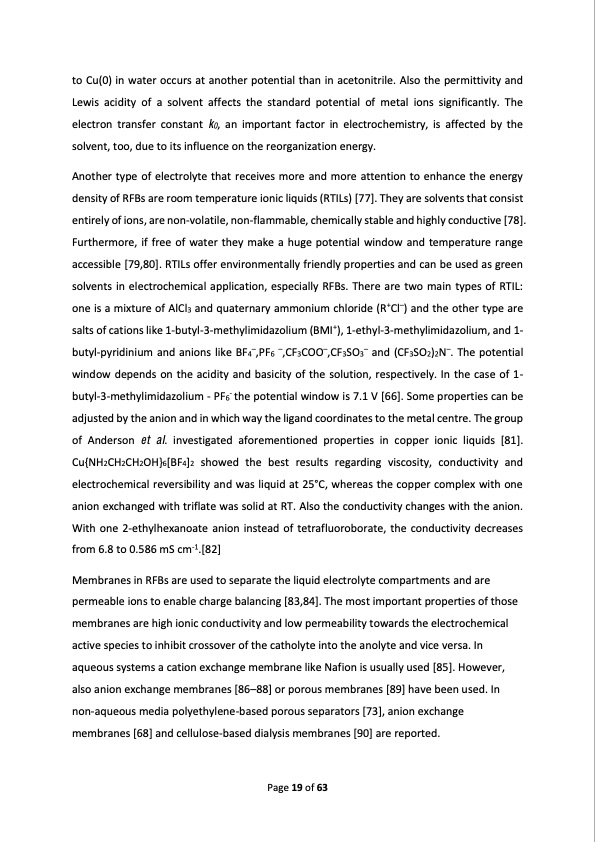
PDF Publication Title:
Text from PDF Page: 019
to Cu(0) in water occurs at another potential than in acetonitrile. Also the permittivity and Lewis acidity of a solvent affects the standard potential of metal ions significantly. The electron transfer constant k0, an important factor in electrochemistry, is affected by the solvent, too, due to its influence on the reorganization energy. Another type of electrolyte that receives more and more attention to enhance the energy density of RFBs are room temperature ionic liquids (RTILs) [77]. They are solvents that consist entirely of ions, are non-volatile, non-flammable, chemically stable and highly conductive [78]. Furthermore, if free of water they make a huge potential window and temperature range accessible [79,80]. RTILs offer environmentally friendly properties and can be used as green solvents in electrochemical application, especially RFBs. There are two main types of RTIL: one is a mixture of AlCl3 and quaternary ammonium chloride (R+Cl�) and the other type are salts of cations like 1-butyl-3-methylimidazolium (BMI+), 1-ethyl-3-methylimidazolium, and 1- butyl-pyridinium and anions like BF4�,PF6 �,CF3COO�,CF3SO3� and (CF3SO2)2N�. The potential window depends on the acidity and basicity of the solution, respectively. In the case of 1- butyl-3-methylimidazolium - PF6- the potential window is 7.1 V [66]. Some properties can be adjusted by the anion and in which way the ligand coordinates to the metal centre. The group of Anderson et al. investigated aforementioned properties in copper ionic liquids [81]. Cu{NH2CH2CH2OH}6[BF4]2 showed the best results regarding viscosity, conductivity and electrochemical reversibility and was liquid at 25°C, whereas the copper complex with one anion exchanged with triflate was solid at RT. Also the conductivity changes with the anion. With one 2-ethylhexanoate anion instead of tetrafluoroborate, the conductivity decreases from 6.8 to 0.586 mS cm-1.[82] Membranes in RFBs are used to separate the liquid electrolyte compartments and are permeable ions to enable charge balancing [83,84]. The most important properties of those membranes are high ionic conductivity and low permeability towards the electrochemical active species to inhibit crossover of the catholyte into the anolyte and vice versa. In aqueous systems a cation exchange membrane like Nafion is usually used [85]. However, also anion exchange membranes [86�88] or porous membranes [89] have been used. In non-aqueous media polyethylene-based porous separators [73], anion exchange membranes [68] and cellulose-based dialysis membranes [90] are reported. Page 19 of 63PDF Image | Redox Flow Batteries Concepts Chemistries

PDF Search Title:
Redox Flow Batteries Concepts ChemistriesOriginal File Name Searched:
5870EAF5-2D70-44C8-A0A7-62D3A1462269.pdfDIY PDF Search: Google It | Yahoo | Bing
Salgenx Redox Flow Battery Technology: Salt water flow battery technology with low cost and great energy density that can be used for power storage and thermal storage. Let us de-risk your production using our license. Our aqueous flow battery is less cost than Tesla Megapack and available faster. Redox flow battery. No membrane needed like with Vanadium, or Bromine. Salgenx flow battery
| CONTACT TEL: 608-238-6001 Email: greg@salgenx.com | RSS | AMP |